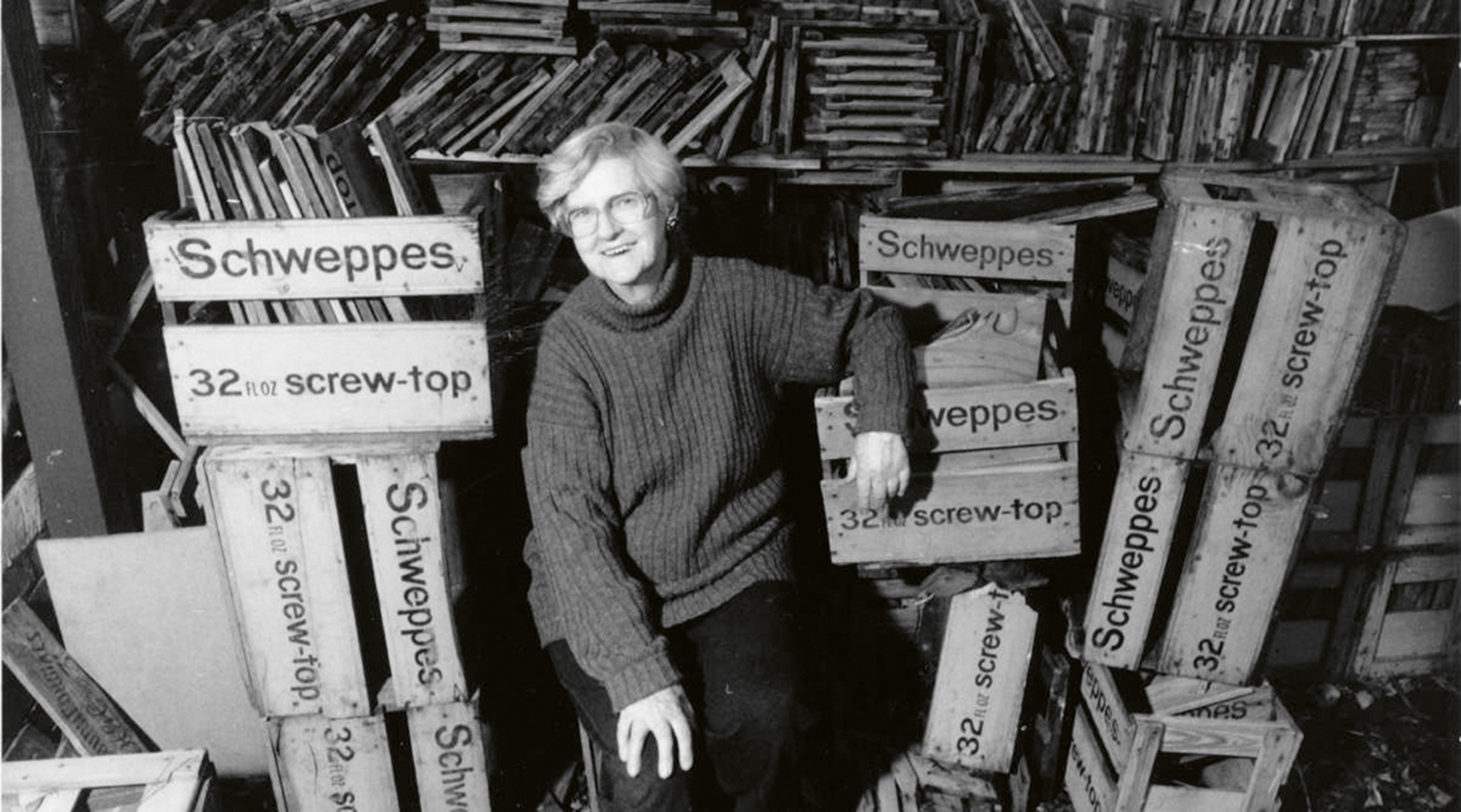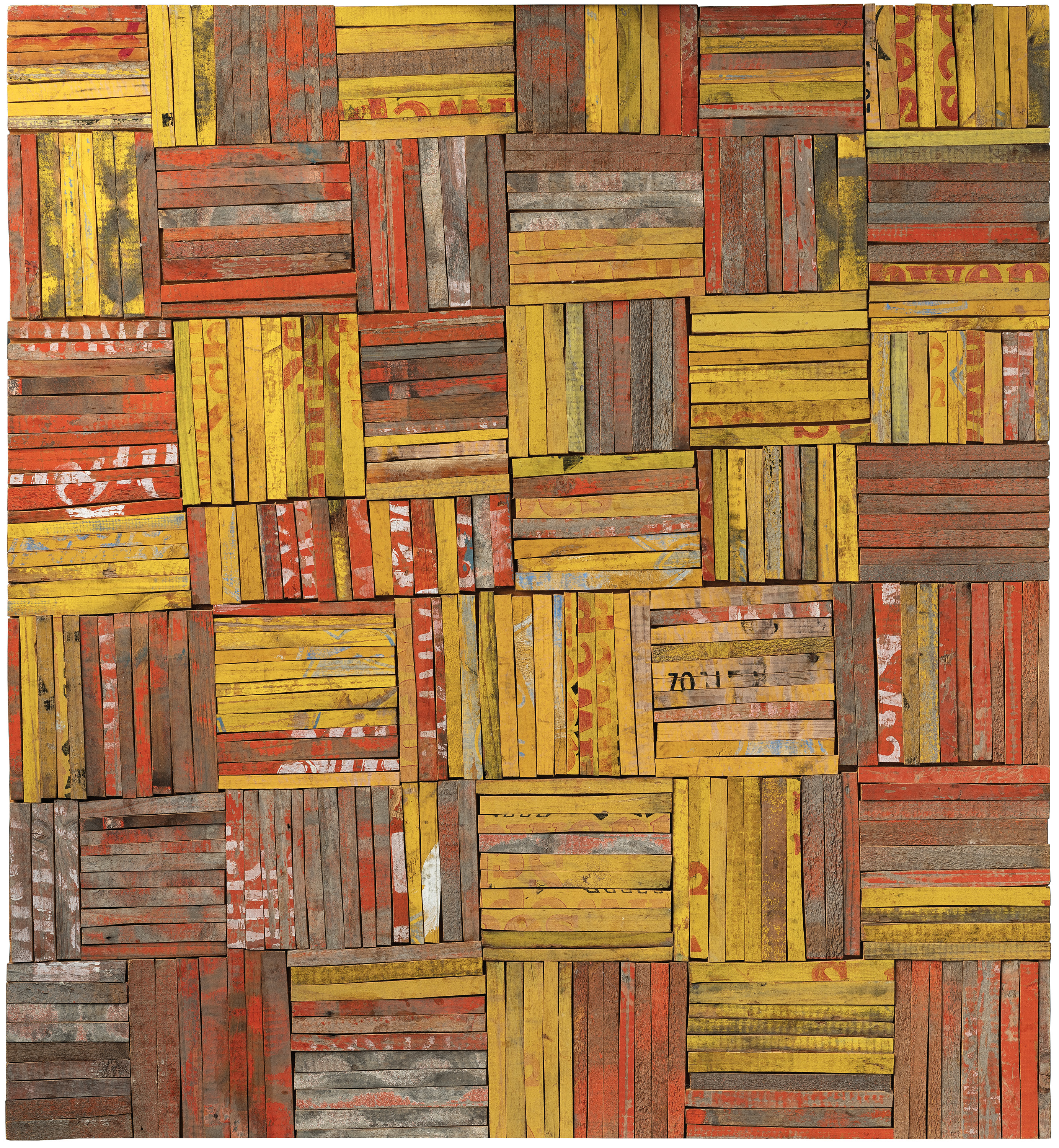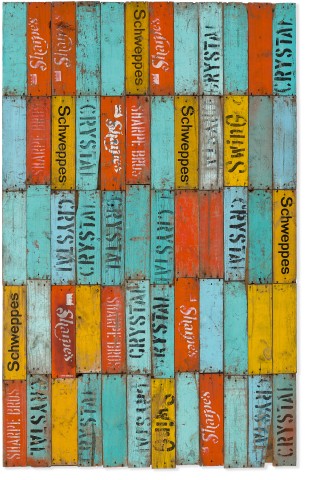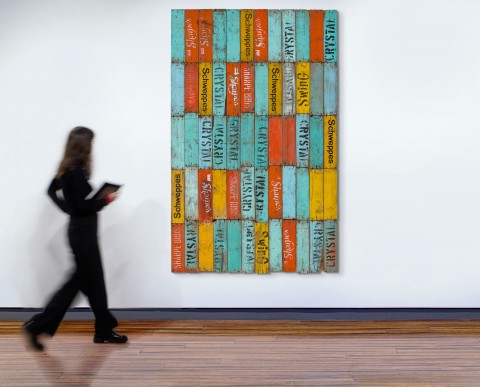THE FALL, 1981
ROSALIE GASCOIGNE
painted and stencilled wooden boards from soft-drink boxes on plywood backing
218.0 x 137.0 cm
signed, dated and inscribed with title verso: R.G. 1981 / THE FALL
Pinacotheca, Melbourne
Private collection, Sydney, acquired from the above in 1981
Yuill | Crowley, Sydney
Private collection, Sydney, acquired from the above in 2001
Rosalie Gascoigne, Pinacotheca, Melbourne, 29 April – 16 May 1981, cat. 4
Rosalie Gascoigne, National Gallery of Victoria, Melbourne, 19 December 2008 – 15 March 2009, cat. 25
MacDonald, V., Rosalie Gascoigne, Regaro, Sydney, 1998, p. 106
Gellatly, K., Rosalie Gascoigne, Council of Trustees of the National Gallery of Victoria, Melbourne, 2008, pp. 20, 90 (illus.), 135
Gascoigne, M., Rosalie Gascoigne: A Catalogue Raisonné, ANU Press, Canberra, 2019, cat. 209, pp. 201 (illus.), 353
NEW GASCOIGNE IMAGE_cmyk.jpg

While the aesthetic, emotional and intellectual appeal of Rosalie Gascoigne’s work is timeless, its material presence speaks of another era – a period in which the local tip was a treasure trove for those with a keen eye, full of a raft of ‘stuff’, ripe for creative repurposing. One of the artist’s earliest exhibitions showcased elements from a carnival sideshow that she had found at the Bungendore tip, on the outskirts of Canberra1, and across her career, her various finds – of kewpie dolls, beer cans, enamelware, linoleum and apiary boxes, amongst other things, are transformed into works that evoke associations and emotions that far transcend their humble beginnings as timeworn found objects. Gascoigne’s ‘hunting ground’ took in Bungendore, Braidwood, Queanbeyan, Captain’s Flat, Tharwa, Michelago, Bredbo, Cooma, Wee Jasper, Yass, Murrumbateman, Gundaroo and Collector2, as well as the city of Canberra, but she was also not averse to offering a roadside crew some beers in exchange for materials that caught her eye. As her studio assistant, artist Peter Vandermark recalled of these trips:
‘When I went out with her in the car she was almost silent, yet it never felt uncomfortable. At the tip we’d split up and go in different directions. After looking, she’d get me to pick up the things she’d selected. Usually she’d come home with something, a couple of pieces of tin maybe, but it didn’t matter if we returned with nothing. There was no music, I’d drive and she’d just check out the landscape. Rosalie would bring the same things each time: a Thermos of coffee, a packet of date roll biscuits, some pieces of fruit – a snack. We’d take time off. At Captain’s Flat, for example, we’d stop at the oval and if there was a road-working team, she’d go up to them, introduce herself, explain how she used the signs. She knew the best way to get the signs was to carry a slab of beer in the car. She knew the currency of workers.’3
Gascoigne initially discovered an enormous cache of soft drink crates at a depot in Queanbeyan, carrying them home on the roof racks of her car.4 At this early stage, they were available in an array of colours, and discards could be purchased by the truckload. Later, when the artist told Schweppes of her use for their crates, the factory manager gave her unlimited access to their discards yard.5 Sadly, this was not to last, as the company eventually moved to using plastic crates, which were of no interest to her.
dh220889 (flat) cmyk.jpg

discarded soft drink crates on plywood backing
92.0 x 83.5 cm
Using these materials was a time-consuming and labour-intensive exercise, with each horde having to be sorted, stacked, cleaned and dismantled – including pulling out up to forty nails from each box – before the process of beginning the work could even commence.6 The Fall, 1981 dates from a period in which Gascoigne primarily (but not exclusively) used the whole boards of the crates, arranging them in some of the largest and most ambitious works she made with this material. The palette of the crates of the different companies – Crystal, Sharpe’s, Swing and Schweppes – is used to great effect, creating a sense of dappled colour and movement across the work as the typography of the various logos jostle and shimmer; their vertical arrangement creating a sense of the planks falling, like autumn leaves, from the top to the bottom of the composition. Together, the gentle movement of the work’s component parts in concert with its title, powerfully evoke the inevitability of time passing, and of seasonal change.
Named, as Gascoigne’s works characteristically were, well after its completion, The Fall is unusual in the artist’s oeuvre for drawing upon a real-life event for its titular inspiration. The work in part alludes to Mrs Jean Thomas, mother of celebrated curator and art historian Daniel Thomas, who was living in Canberra and working at the National Gallery of Australia when the piece was made. As NGA colleague John McPhee later relayed to Thomas: ‘Rosalie told me that the painting was called The fall after an encounter with your mother. She had seen her making her way from the shops in Kingston to our flat and seemed to be making a tough task of it. She picked her up and took her home. The title was more a reference to our fall from youth, grace, etc, rather than a real fall. Autumnal years I suppose.’7
1. Assemblage, Gallery A, Sydney, 1976.
2. Clark, D., ‘Standing on the Mountain: The Landscape Impulse in Rosalie Gascoigne’s Art’ in Gellatly, K., Rosalie Gascoigne, National Gallery of Victoria, Melbourne, 2008, p. 28
3. Vandermark, P. in Eagle, M., From the Studio of Rosalie Gascoigne, Australian National University Drill Hall Gallery, Canberra, 2000, p. 23
4. Gascoigne cited in Davidson, K. & M. Desmond, Islands: Contemporary Installations from Australia, Asia, Europe and America, National Gallery of Australia, Canberra, 1996, p. 14
5. MacDonald, V., Rosalie Gascoigne, Regaro Pty Ltd, Sydney, 1998, pp. 33 – 34
6. Gascoigne, S.C.B., ‘The Artist-in-Residence’ in Eagle, op.cit., p. 12
7. Personal communication, Daniel Thomas to Martin Gascoigne, 2004 cited in Gascoigne, M., Rosalie Gascoigne: A Catalogue Raisonné, Australian National University Press, Canberra, 2019, p. 201
KELLY GELLATLY

